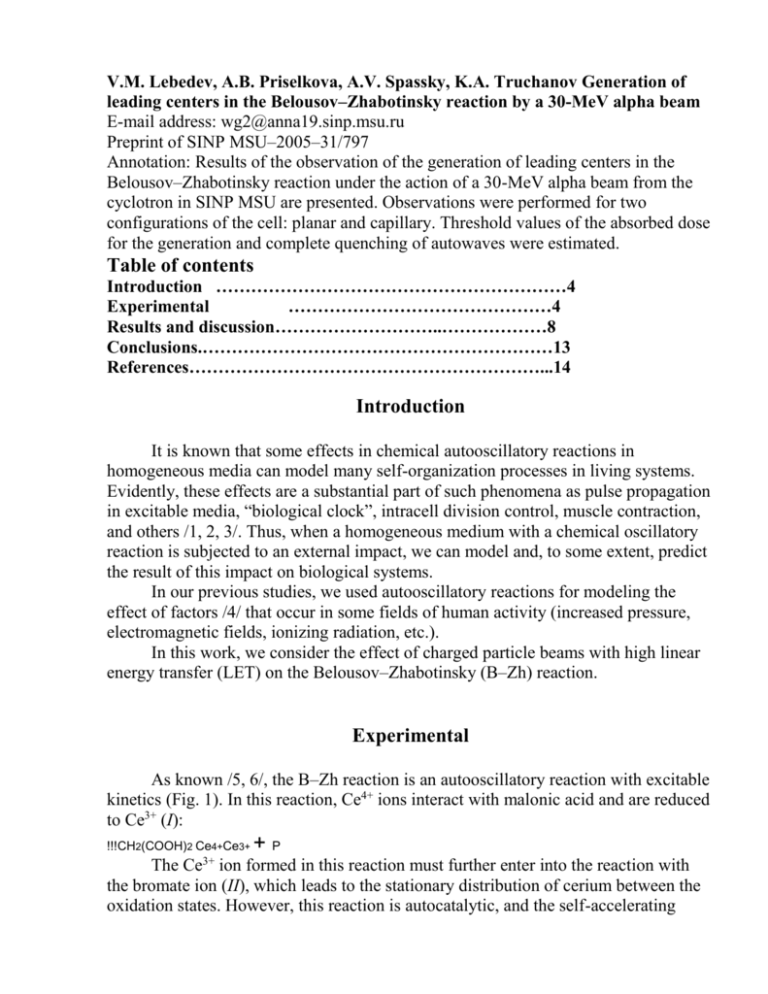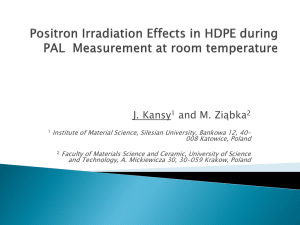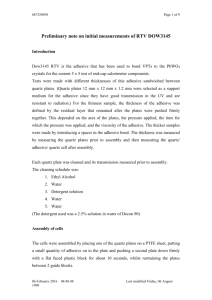observed corresponding
advertisement

V.M. Lebedev, A.B. Priselkova, A.V. Spassky, K.A. Truchanov Generation of
leading centers in the Belousov–Zhabotinsky reaction by a 30-MeV alpha beam
E-mail address: wg2@anna19.sinp.msu.ru
Preprint of SINP MSU–2005–31/797
Annotation: Results of the observation of the generation of leading centers in the
Belousov–Zhabotinsky reaction under the action of a 30-MeV alpha beam from the
cyclotron in SINP MSU are presented. Observations were performed for two
configurations of the cell: planar and capillary. Threshold values of the absorbed dose
for the generation and complete quenching of autowaves were estimated.
Table of contents
Introduction ……………………………………………………4
Experimental
………………………………………4
Results and discussion………………………..………………8
Conclusions.……………………………………………………13
References……………………………………………………...14
Introduction
It is known that some effects in chemical autooscillatory reactions in
homogeneous media can model many self-organization processes in living systems.
Evidently, these effects are a substantial part of such phenomena as pulse propagation
in excitable media, “biological clock”, intracell division control, muscle contraction,
and others /1, 2, 3/. Thus, when a homogeneous medium with a chemical oscillatory
reaction is subjected to an external impact, we can model and, to some extent, predict
the result of this impact on biological systems.
In our previous studies, we used autooscillatory reactions for modeling the
effect of factors /4/ that occur in some fields of human activity (increased pressure,
electromagnetic fields, ionizing radiation, etc.).
In this work, we consider the effect of charged particle beams with high linear
energy transfer (LET) on the Belousov–Zhabotinsky (B–Zh) reaction.
Experimental
As known /5, 6/, the B–Zh reaction is an autooscillatory reaction with excitable
kinetics (Fig. 1). In this reaction, Ce4+ ions interact with malonic acid and are reduced
to Ce3+ (I):
!!!CH2(COOH)2 Ce4+Ce3+
3+
+P
The Ce ion formed in this reaction must further enter into the reaction with
the bromate ion (II), which leads to the stationary distribution of cerium between the
oxidation states. However, this reaction is autocatalytic, and the self-accelerating
mode is preceded by an induction period. The reaction is switched on not
immediately, and, therefore, during the induction period nearly all Ce4+ ions are
transformed into Ce3+. The light-yellow color of the solution, which is caused by light
absorption in the visible region by the Ce4+ complex, disappears. After the end of the
induction period, self-accelerating rapid transformation of Ce3+ ion to Ce4+ occurs,
and the solution is colored again. In other words, until all Ce4+ is not transformed into
Ce3+, the latter does not begin to oxidize. Thus, the reaction proceeds for some time,
next stops, next begins again, and so on until all initial reactants are consumed.
The periodic character of the process is explained as follows. Reaction (I)
yields bromide ions, which retard reaction (II). However, the concentration of
bromide in the system depends on the rate of the reaction in which bromide is
consumed because of the interaction with bromate. If the concentration of bromide is
sufficiently high, reaction (II) stops, because Ce4+ is not regenerated in the oxidation
of Ce3+ by bromate, and, as a result, the catalytic cycle is interrupted. When the
concentration of Ce4+, which decreases as a result of reaction (I), reaches the
minimum possible value, the concentration of Br– begins to sharply decrease. Then
reaction (II) significantly accelerates, and the concentration of Br– begins to rapidly
increase thus retarding reaction (II). Then the entire cycle is repeated.
Fig. 1. Scheme of the Belousov–Zhabotinsky reaction.
In this work, we consider the effect of charged particle beams with high linear
energy transfer on the Belousov–Zhabotinsky reaction. In particular, this factor occurs
in outer space.
For the irradiation of samples, we used an alpha-beam from the 120-cm
cyclotron at the Institute of Nuclear Physics, Moscow State University. Ferroin, the
complex of Fe(II) with phenanthroline (phen), was used as the catalyst instead of
Ce4+. This catalyst was selected because ferroin has bright blue color and changes it to
red on the transition Fe(II) → Fe(III), which allows the visualization of the process
dynamics. Generally, the participation of ferroin in the process can be described by
the following reaction:
6 [Fe(phen)3]2+ + 6H30+ + BrO3– → 6 [Fe(phen)3]3+ 9 H20 + Br–.
The schematic diagram of the setup in presented in Fig. 2. The alpha-beam
from cyclotron (1) passed by the ion guide (4) through quadrupole lenses (2),
deflecting magnet (3), protective wall (5), and further through the system of
diaphragms (7) and a vacuum valve (6), went into air from the window (8) of the ion
guide, and arrived to a working cell or a capillary (10). As the window at the edge of
the ion guide, we used aluminum foil with the thickness of 50 µm. In some
experiments, the beam was collimated with an additional replaceable diaphragm (9) of
different configurations. This diaphragm was mounted on a rod moving with a micro
engine, which allowed the remote control of the introduction and removal of the
diaphragm (or interception of the beam).
The diameter of the round diaphragm was 2 mm; the slit width was also 2 mm.
The diaphragm was made of tantalum because induced radioactivity in it is low
because of the high Coulomb barrier.
Fig. 2. Schematic diagram of the setup: (1) cyclotron, (2) quadrupole lenses, (3)
deflecting magnet, (4) ion guide, (5) protective wall, (6) vacuum valve, (7)
diaphragms, (8) ion guide window, (9) replaceable diaphragm, (10) working cell or
capillary, (11) web camera.
Image acquisition of the process was performed with a Philips web camera (11)
and a computer, which was connected to the camera through three USB repeaters
arranged in series with a total length of 15 m. The image was recorded to the hard
disk of the computer in the on-line mode. Then the color in analyzed points was
decomposed into RGB components in the off-line mode using the color capture
program. The results were used for the quantitative analysis of autowave processes.
The arrangement of some elements of the setup is shown in more detail in Fig. 3.
<text boxes>: replaceable diaphragms; cell; ion guide outlet window; web camera;
electric
Fig. 3. Setup (photo).
The beam was monitored by varying the value of the charge at the diaphragm
and the cell, which were isolated from the earth. A current integrator with a sensitivity
of 2×10−4 µC/?pulse and a ?converting device were used. To improve the uniformity
of charge density of the accelerator over the window area, the beam was somewhat
defocused with magnetic quadrupole lenses of the cyclotron and periodically
controlled using a scintillation screen. The accuracy of the determination of absorbed
dose was estimated at 30%.
The action of a cyclotron alpha-beam on the B–Zh reaction was studied at two
geometries: planar two-dimensional and one-dimensional. In the first case, we used a
special duralumin ring-shaped cell with the outer and inner diameters of 60 and 20
mm, respectively, and a thickness of 30 mm. In the central part of the cell, the
reaction mixture was placed between two lavsan films with a thickness of 20 µm
tightened at the inner part of the cell ring. The gap between the films was from 0.8 to
1.0 mm. The cell was filled with a solution with a syringe through a special hole and
placed behind the window of the ion guide at a distance of 5–7 cm.
In the second case, a Pyrex capillary with a length of 90 mm and outer and
inner diameters of 1.2 and 0.9 mm, respectively, were placed instead of the cell. The
capillary was located in the horizontal plane perpendicularly to the beam.
Energy losses of alpha particles in the window of the ion guide and in the air
layer were 4.3 MeV, and the energy of alpha particles at the outer surface of the
lavsan film or capillary was 26.2 MeV. LET of alpha particles with this energy is
about 6 keV/µm ?of water and decreases with particle slowdown in the solution. The
radiation quality coefficient was 2 and above.
The energy of alpha particles arriving at the reaction mixture changed from
18.5 MeV at the capillary axis to 5.5 MeV and lower at the edges because particles
passed the Pyrex layer of different thickness. LET of alpha particles at the end of the
path was up to 2×101 keV/µm of water.
Thermal convection and diffusion during the experiment both in the chamber
and in the capillary can be neglected.
Results and discussion
On the irradiation of the solution in the cell with the diaphragm 2 mm in
diameter, concentric waves centered at the irradiated portion of the solution were
initiated (Fig. 4) , and the process of the formation of the wave front was repeated
several times even after the end of the irradiation. The time of irradiation and the
intensity of the beam were varied in the range from ? 1 to 30 nA. The ratio of bromine
and malonic acid (MA) in the solution was also varied (from 1 : 1 to 1 : 10). It was
found that the most stable wave initiation corresponded to the ratio of these
components of 1 : 6 and was nearly independent on the intensity of the beam. In Fig.
4a, spontaneous waves over the entire area of the cell and the formation of the first
concentric wave around the slit are seen. Fig. 4b shows a clear concentric wave
(second after the end of irradiation) and the trail of the first wave, and Fig. 4c shows
the third (after the end of irradiation) wave and trails of the second concentric wave
(corresponding video record of the process is presented in Appendix 1 to the ?on-line
version of the preprint).
<text boxes>: 15 s; 75 s; 105 s; a; b; c
Fig. 4. Wave initiation in the cell with the round diaphragm. Initial
concentration of compounds (M): [MA] = 0.6, [NaBrO3] = 0.1, [Fe(phen)3] = 5×10–5,
[H2SO4] = 1.5 ( the time from the beginning of irradiation is shown in the figures; the
color of the solution is distorted).
When the slit diaphragm was used (Fig. 5), the front of the initiated wave
replicated the shape of this diaphragm and had the form of two diverging planar
waves. After the end of irradiation, the formation of two or three additional waves of
the waves of the same shape but with lower intensity was observed (corresponding
video record of the process is presented in Appendix 2 to the ?on-line version of the
preprint).
<text boxes>: 5 s; 10 s; 120 s; 180 s
Fig. 5. Wave initiation in the cell with the slit diaphragm. Initial concentration
of compounds (M): [MA] = 0.3, [NaBrO3] = 0.1, [Fe(phen)3] = 5×10–5, [H2SO4] = 1.5
( the time from the beginning of irradiation is shown in the figures).
The most stable formation of the leading center was observed on the irradiation
of the solution in the capillary (Fig. 6). In this case, two nearly planar waves diverged
I opposite directions from the center of irradiation. The minimum value of the
absorbed dose at which the formation of the leading center was observed was
estimated at 8×101 Gy. It should be noted that in this case the energy distribution of
alpha particles in the solution not only was nonuniform in depth, but also depended on
the place of their arrival at the surface of the capillary (corresponding video record of
the process is presented in Appendix 3 to the ?on-line version of the preprint).
The superposition of the waves induced by the beam with the spontaneous
waves, which commonly occur in the solution, resulted in their mutual cancellation.
Figure 7 presents the time-base sweep of the blue component of the RGB
resolution in the point separated by 10 cm from the center of irradiation. In the
figures, arrows indicate time intervals corresponding to the irradiation of the cell. In
the figures, it is seen that the frequency of wave generation in the considered point
depends on the geometry of the reaction volume and the shape of the diaphragm.
<text boxes>: s → с;
Fig. 6. Wave initiation in the capillary. Initial concentration of compounds (M):
[MA] = 0.0048, [NaBrO3] = 0.0036, [Fe(phen)3] = 5×10–5, [H2SO4] = 0.3 ( the time
from the beginning of irradiation is shown in the figures; the color of the solution is
distorted).
The interval between passing two repeated waves is about 35 s in the cell with
the diaphragm in the form of a round window, about 65 s in the cell with the slit
diaphragm, and about 100 s in the capillary. The dependence of autooscillations on
the shape of the reaction volume is evidently related to the radical nature of the
processes that occur in the reaction mixture. It should be also noted that the intensity
of waves after single irradiation decreases with time.
On the irradiation of the entire volume of the reaction mixture in the cell with
the alpha beam at doses of about 60 kGy, the autowave process stopped in the entire
volume of the cell (Fig. 8). After the end of irradiation, the autowave process restarted
within 2–3 min (corresponding video record of the process is presented in Appendix 4
to the ?on-line version of the preprint). As known, a similar situation is observed on
the continuous addition of Br– anions to the system. Thus, it can be assumed that
high-LET ionizing radiation activated the reaction of the reduction of bromate ions to
bromide anions. This conclusion is confirmed in part by the change in color on the
irradiation of the acidic solution containing potassium bromate and ferroin form blue
to red and the return to the initial color after the end of irradiation (ferroin is an
indicator of redox processes).
<text boxes>: intensity; t, s; a; b; c
Fig. 7. Time-base sweep of the blue component of the RGB resolution in the
point separated by 10 cm from the center of irradiation; (a) for the cell with the
diaphragm I the form of a round window, (b) for the cell with the slit diaphragm, and
(c) for the capillary. Arrows denote the beginning and the end of irradiation.
Only two experiments were described in the literature, where the irradiation of
the B–Zh reaction with hard ionizing radiation was considered and its influence on
autooscillatory processes was studied /7, 8/. In these experiments, Co60 gammaradiation was used, and the entire reaction volume was irradiated. Even if the leading
centers were generated on this irradiation (although this is improbable because of low
LET values), these centers immediately quenched each other and could not be
observed. In these works, only the suppression of autooscillations under the action of
gamma irradiation was observed.
<text boxes>: 0 s; 10 s; 20 s; 30 s
Fig. 8. Disappearance of autowaves under the action of hard radiation 1.
{Footnote: 1 Dots in the photograph are gas bubbles. Chromatographic analysis
demonstrated the presence of hydrocarbons in the composition of the gas mixture,
which can indicate that free-radical processes occur in the system.} Initial
concentration of compounds (M): [MA] = 0.004, [NaBrO3] = 0.1, [Fe(phen)3] = 5×10–
5
, [H2SO4] = 1.5 (the time from the beginning of irradiation is shown in the figures).
The generation of new leading centers can be a result of radical reactions
initiated under the action of hard radiation. In /9/, the initiation of the reaction
•O2CH(CO2H2)
+ CH2(CO2H)2 ⇒ HO2CH(CO2H)2 + •CH(CO2)H2
was observed in the studies of the radiolysis of malonic acid under the action of a
high-energy electron beam. In the opinion of the authors of /9/, this process can play
an important role in the B–Zh reaction. In our opinion, this reaction can also cause the
generation of new leading centers.
Conclusions
Thus, the generation of leading centers in an oscillatory reaction of the B–Zh
type under the action of collimated radiation with high linear energy transfer was
observed for the first time. Complete quenching of autowave processes under the
action of total irradiation of the reaction volume was also observed. Along with their
fundamental importance, the observed effects can be used for modeling processes of
the radiation injury of living systems under the action of the radiation of this type.
Conclusions
1. Г. Николис, И. Пригожин. Самоорганизация в неравновесных системах.
М.: Мир, 1979, с. 512.
2. Г. Хакен. Синергетика. М.: Мир, 1985, с. 419.
3. В. Эбелинг. Образование структур при необратимых процессах. М.: Мир,
1979, с. 279.
4. А.В. Спасский, К.А. Труханов, А.Б. Приселкова, В.М. Лебедев.
Autooscillations and autowaves in chemical systems under the action of extreme
conditions. Третий съезд биофизиков России, 24-29 июня 2004 г.,
Воронеж. Тезисы докладов. Том II. с. 318.
5. A.M. Zhabotinsky. Concentration oscillations. Moscow: «Nauka», 1974,
p. 179.
6. Колебания и бегущие волны в химических системах. Под ред. Р. Филда,
М. Бургер. М.: Мир, 1988, 720 с.
7. E. Kőrös, G. Putirskaya, M. Varga. Perturbation of bromate oscillators I,
Perturbation by γ-irradiation. Acta Chimica Scientiarum Hungaricae, Tomus 110
(3), p. 295-303 (1982).
8. K.V.S. Rama Rao, D. Prasad, Radiolysis-Driven Dormancy of a Ce4+ Catalyzed
Belousov-Zhabotinskii Chemical Oscillator, Kinetics of PhysicoChemical Oscillations, Discussion Meeting, Aachen, Deutsche Bunsen Gesellschaft
für Physicalische Chemie, preprints of submitted papers, p. 82 (1979).
9. M.N. Schuchmann, Raghavendra Rao, M. Hauser, S.C. Müller, C. Von
Sonntag. The reaction of the malonic acid derived radical with oxygen. A
reinvestigation by pulse radi olysis. J. Chem. Soc, Perkin Trans. 2, 2000, p. 491493.







